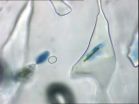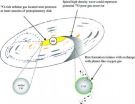(Press-News.org) ATLANTA -- An enzyme viewed as an executioner, because it can push cells to commit suicide, may actually short circuit a second form of cell death, researchers at Emory University School of Medicine have discovered.
The finding could shift drug discovery efforts, by leading scientists to rethink how proposed anti-cancer and anti-inflammatory drugs that target the enzyme, called caspase 8, are supposed to work. The results are described in this week's Nature.
Caspase 8 has been described as "the killer you can't live without." This enzyme plays a key role in apoptosis, a form of cellular suicide important for the development of all multicellular organisms, and in defense against viral infections. Mice lacking caspase 8 die before birth, because their blood vessels and blood-forming stem cells fail to develop properly. In the Nature paper, Emory researchers show that mice without caspase 8 develop normally if they also lack another enzyme called RIP3.
"The surprising aspect is that caspase 8 appears to have two functions: one that initiates apoptosis and a second that restrains an independent programmed death pathway," says senior author Ed Mocarski, PhD, Robert W. Woodruff Professor of Microbiology and Immunology at Emory Vaccine Center and Emory University School of Medicine.
Graduate student William Kaiser, in Emory's Microbiology and Molecular Genetics program, is the first author of the paper. Other Emory authors include Tamara Caspary, PhD, assistant professor of human genetics, as well as students and postdoctoral fellows from both Emory labs.
"It's remarkable to be able to rescue mice from embryonic death," Caspary says. "I was surprised that the mice are even born, since these enzymes are basic parts of the cellular machinery."
In humans, a lack of caspase 8 has been linked to immune disorders and skin diseases such as eczema, while too much caspase 8 activity has been connected with diabetes. In addition, several experimental anti-cancer and anti-inflammatory drugs aim to alter caspase 8 levels in order to induce death in cancer cells or reduce inflammation.
"Until recently, scientists viewed programmed cell death mainly as apoptosis, a program of self-destruction deliberately set in motion through signals cells receive from outside," Mocarski says.
For example, apoptosis ensures that white blood cells responding to an infection don't multiply indefinitely. White blood cells have built-on triggers on their surfaces that activate caspase 8, which unleashes a cascade of enzymes that break down the contents of the cell.
In contrast to apoptosis, necrosis was seen as unregulated death by neglect, until the discovery of an alternative form of cell death, driven by RIP3, called programmed necrosis. This looks like necrosis under the microscope, but like apoptosis is orchestrated by the cell from within rather than occurring because of injury or infection. Mocarski's group recently showed that RIP3 enables cells to sabotage themselves if they are infected by a virus, an activity where apoptosis was once thought to be the most important.
"For several years, the puzzle was: what are the non-apoptotic functions of caspase 8, since there are numerous systems that are impacted by not having it," Mocarski says. "Now we have to consider that the absence of caspase 8 is actually revealing death by RIP3."
Mice lacking both caspase 8 and RIP3 have blood vessels and blood cells that look healthy. However, a few months after birth, they develop swollen lymph nodes, because their white blood cells do not go through apoptosis normally. Other scientists have shown that mice that have caspase 8 missing only in the skin have chronic skin inflammation, a condition resembling eczema in humans.
"Our results indicate that whatever caspase 8 was doing in the skin, removing RIP3 takes care of it," Mocarski says.
###
The National Institutes of Health supported this research.
Reference: W.J. Kaiser, J.W. Upton, A.B. Long, D. Livingston-Rosanoff, L.P. Daley-Bauer, R. Hakem, T. Caspary and E.S. Mocarski. RIP3 mediates the embryonic lethality of caspase-8-deficient mice. Nature (2011).
Source of "killer" quote: http://www.ncbi.nlm.nih.gov/pubmed/10802696
Written by Quinn Eastman
The Robert W. Woodruff Health Sciences Center (http://www.whsc.emory.edu/home/about) of Emory University is an academic health science and service center focusing on teaching, research, health care and public service.
END
Sea-ice algae – the important first rung of the food web each spring in places like the Arctic Ocean – can engineer ice to its advantage, according to the first published findings about this ability.
The same gel-like mucus secreted by sea-ice algae as a kind of antifreeze against temperatures well below minus 10 C is also allowing algae to sculpt microscopic channels and pores in ice that are hospitable to itself and other microorganisms.
Altering ice to their benefit should help sea-ice algae adapt to a warming world, which is good news for hungry fish and shellfish ...
Fraser Yachts is pleased to announce the following charters available for Mediterranean yacht charter and Caribbean yacht charter for 2011/12. M/Y Pamela V yacht is a luxurious 45.9m Hakvoort built yacht, available for yacht charter in the Bahamas and the British Virgin Islands. During the high season, it will be available for $235,000 per week and in the low season will go down to $220,000. Currently located in the Caribbean, this luxury yacht is due to be completed later this year. With the ability to sleep 8 guests in 4 staterooms, and 10 crew members, you can expect ...
Researchers have synthesized the vast literature on cancer to produce a next-generation view of the features that are shared amongst all cancer cells. These hallmarks of the disease provide a comprehensive and cohesive foundation for the field that will influence biomedical researchers in their quest for new cancer treatments.
The review article by Douglas Hanahan of École Polytechnique Fédérale in Switzerland and Robert Weinberg of the Whitehead Institute for Biomedical Research appears in the March 4th issue of Cell, a Cell Press publication. The new article updates ...
Low physical activity increases kidney transplant patients' likelihood of dying early, according to a study appearing in an upcoming issue of the Clinical Journal of the American Society Nephrology (CJASN). The results suggest that patients need to exercise to fend off an early death.
Inactive people in general face increased risks of developing cardiovascular disease and of dying prematurely. Individuals with chronic kidney disease—particularly those on dialysis—tend to get little exercise, but most increase their activity levels modestly after receiving a kidney transplant. ...
Evidence for a diversified sea-based economy among North American inhabitants dating from 12,200 to 11,400 years ago is emerging from three sites on California's Channel Islands.
Reporting in the March 4 issue of Science, a 15-member team led by University of Oregon and Smithsonian Institution scholars describes the discovery of scores of stemmed projectile points and crescents dating to that time period. The artifacts are associated with the remains of shellfish, seals, geese, cormorants and fish.
Funded primarily by grants from the National Science Foundation, the ...
Old Westbury, New York (Mar. 3, 2011) – Fossil records verify a long-standing theory that horses evolved through natural selection, according to groundbreaking research by two anatomy professors at New York College of Osteopathic Medicine (NYCOM) of New York Institute of Technology.
Working with colleagues from Massachusetts and Spain, Matthew Mihlbachler, Ph.D., and Nikos Solounias, Ph.D. arrived at the conclusion after examining the teeth of 6,500 fossil horses representing 222 different populations of more than 70 extinct horse species. The records, spanning the past ...
Optics researchers from the Universities of Glasgow and Bristol have developed an iPad application for accurate, easy and intuitive use of optical tweezers.
Optical tweezers, used to manipulate tiny particles through the use of highly focused laser beams, are the tool at the heart of much molecular biology – helping us to experiment with and better understand the microscopic processes of organisms.
Research published today, Friday 4 March 2011, in IOP Publishing's Journal of Optics, shows how a team of researchers has overcome the limitations of computer mouse and ...
Johns Hopkins scientists have discovered that PARIS — the protein — facilitates the most common form of Parkinson's disease (PD), which affects about 1 million older Americans. The findings of their study, published March 4 in Cell, could lead to important new targets for treatment.
Previous research has shown that a protein dubbed parkin protects brain cells by "tagging" certain toxic elements for natural destruction. Mutations in the parkin gene cause rare forms of PD that run in families, but its role remained unclear in sporadic late-onset PD, the prevalence of which ...
Star-shaped cells in our brains called astrocytes were once considered little more than structures to fill the gaps between all-important neurons. But more recent evidence has emerged to reveal that those astrocytes play more than a supporting role; they are involved in information processing and signal transmission and they help to regulate the shapes of our neurons and their connections to one another.
Now, researchers reporting in the March 4th Cell, a Cell Press publication, have found that astrocytes are also essential for making long-term memories. When they don't ...
Scientists have performed a micro-probe analysis of the core and outer layers of a pea-sized piece of a meteorite some 4.57 billion years old to reconstruct the history of its formation, providing the first evidence that dust particles like this one experienced wildly varying environments during the planet-forming years of our solar system.
The researchers interpret these findings as evidence that dust grains traveled over large distances as the swirling protoplanetary nebula condensed into planets. The single dust grain they studied appears to have formed in the hot ...



